
How do I implement objectives and key results (OKR) correctly?
Do you know this? Everyone in the team works diligently - but in the end there is no common focus. This is exactly where OKR comes in: Objectives and Key Results help you to set measurable goals that really count. Used correctly, the framework brings more clarity, direction and momentum to your organization. OKR serves as a bridge between the strategic vision and operational implementation and is a key tool for setting priorities and managing processes. Instead of endless to-do lists, you create real impact.
Your company's vision forms the starting point for setting goals in the OKR process. OKR promotes the development of the organization as an ongoing, transformative process that has a lasting impact on structures, processes and corporate culture. If you use OKR correctly, you will bring more transparency, common alignment, real focus and noticeable agility to your organization - and that's exactly what it's all about.
In this article, you will learn everything you need to know about the OKR method. From the basics and the correct formulation of goals to the successful introduction in your company. We will show you step by step how to use OKR as a flexible framework and tool for leadership and transformation and how to avoid typical mistakes.
Where does the OKR Framework actually come from? A brief look back.
The roots of OKR go back to the 1970s. Back then, Andy Grove - co-founder of Intel - developed the framework in order to set clearer goals within the company and track them in a more measurable way. One of his employees was John Doerr, who later came on board as an investor at Google. He brought the concept with him, which he described as "a simple goal-setting system" - and that was exactly what convinced him.
In 2000, Google introduced OKR - laying the foundation for an unprecedented success story. In 2013, the company finally published the presentation "How Google sets goals: OKR", which attracted worldwide attention.
Since then, OKR has developed into a real success model - especially for ambitious companies that want to grow with focus, clarity and agility. Whether you are a start-up or a large corporation: OKR helps you to get to the heart of your goals and achieve them effectively together.
Why OKR? The advantages at a glance
If you use OKR correctly, you can make real progress on many levels - both strategically and operationally. OKR serves as an instrument and leadership tool for modern management, helping companies to clearly define their goals and improve employee management.
OKR also acts as a bridge between the strategic vision and operational implementation by linking the corporate strategy with day-to-day tasks. Setting clear priorities in the OKR process ensures that the most important objectives are selected for each cycle and resources are targeted.
Clear processes are crucial in order to make the implementation of objectives efficient and to support strategy implementation.
Continuous measurement and evaluation of target achievement based on key results makes it possible to track progress transparently and objectively assess the success of OKR implementation.
Here are the most important benefits of a well thought-out OKR implementation:
Focus that works:
OKR helps you to focus on the essentials. When selecting the most important goals, priorities play a decisive role in ensuring that resources are used optimally. Instead of getting lost in countless tasks, you and your team concentrate on the goals that really count. The task of clearly defining these goals is a key challenge in the OKR process.
Measurable progress:
With clear key results, you make your goals concrete and tangible. You not only recognize whether you are making progress - but how far. Progress is measured on the basis of key results, which, as part of the OKR management system, enable systematic success control and monitoring of target achievement through key results.
Transparency throughout the company:
OKR creates visibility. You recognize more quickly where things are going wrong - be it due to bottlenecks, incorrect assumptions or blockages. Problems become visible earlier and can therefore be solved.
More speed and agility:
The regular OKR cycle allows you to adapt your goals flexibly to changes. The continuous development of your organization is promoted by the ongoing adaptation and review in the OKR process. This keeps your organization agile - without losing sight of the big picture.
OKR frameworks make it possible to design the OKR process flexibly and improve it in a targeted manner so that the system can be optimally tailored to the needs of your company.
Empowerment for your team:
OKR actively invites employees to participate in setting goals. As central players, people are at the heart of the OKR system and are specifically strengthened by this management tool. This not only increases commitment, but also promotes personal responsibility and entrepreneurial thinking within the team.
Better collaboration across borders:
With OKR, you promote cross-departmental collaboration. Silos break down, common goals connect - and suddenly teams are working together instead of side by side.
For all of this to work, one thing is crucial: you must be prepared to embrace the basic principles of OKR work. You can find out what these are in the next section.
The three pillars of the OKR method
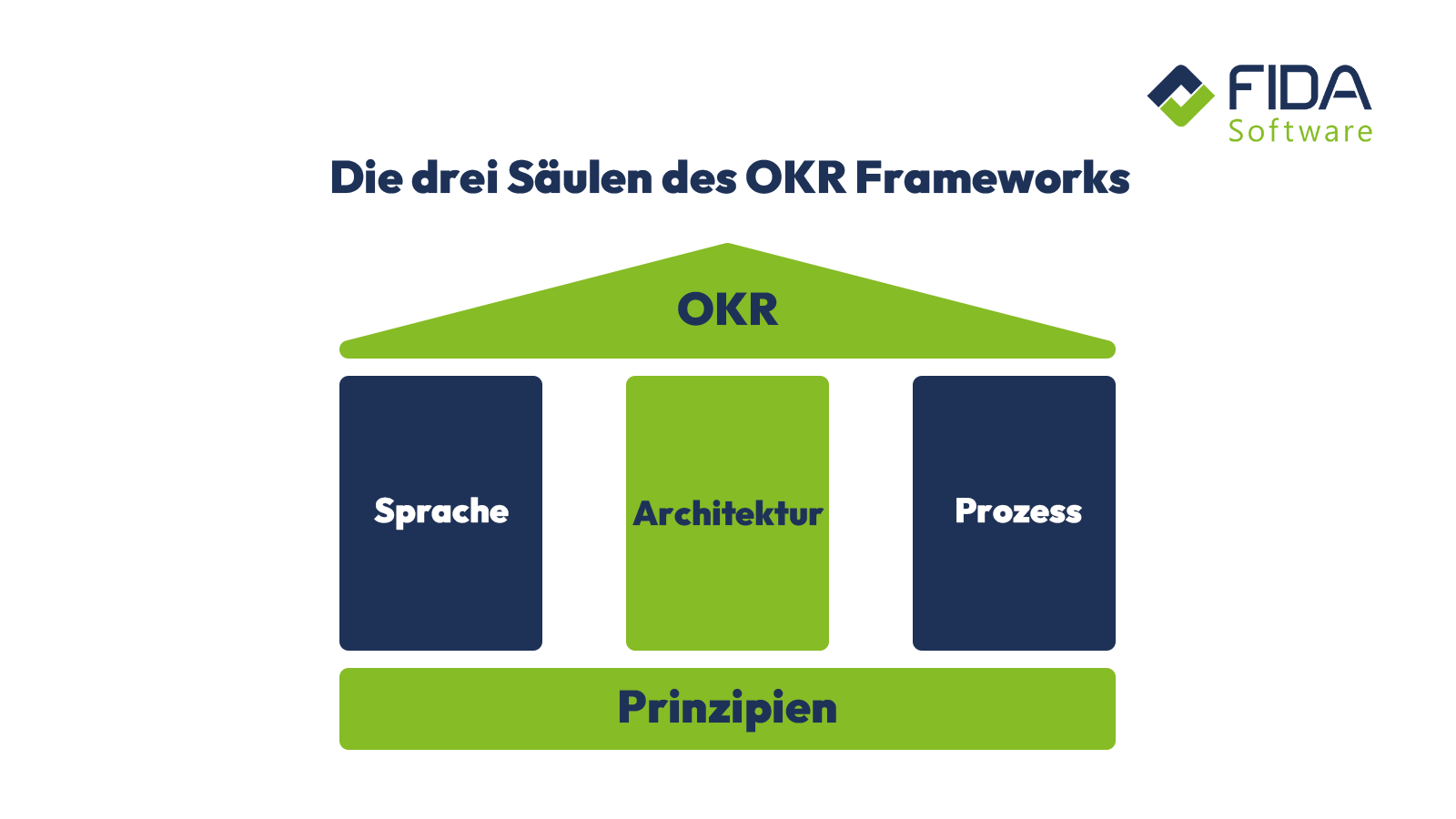
Pillar 1: OKR as a linguistic convention - Objective & Key Results
An OKR always consists of two parts:
The objective and the key results.
The objective describes qualitatively what you want to achieve. The key results, on the other hand, show measurably how you can recognize that the objective has been achieved. Clear key results are crucial for measuring progress and monitoring the success of goal achievement. Google, for example, has been using the definition of key results to effectively manage and measure strategic goals since 1999.
A good objective is qualitatively formulated, clear, concise and comprehensible. It should inspire and motivate, not contain a plan of action or activities, but describe a desired target state.
Good key results are quantitatively measurable, clearly and unambiguously defined. Between 2 and 5 key results should be formulated for each objective. They do not describe activities, but measurable results that can be evaluated at the end of a cycle. These key results are used for objective measurement and make success transparent.
It is important to note that objectives and key results only work together. Key results concretize the objective and make progress visible - like an ongoing pulse check. This is why the method is called "OKR" (Objectives & Key Results) and not just "O" or "KR".
A common mistake is to formulate OKRs as to-do lists. Statements like
"We are launching product X"
are activities, not measurable results. Instead, an outcome should be formulated, for example:
"Product X achieves 10,000 active users within 3 months".
If it is difficult to formulate outcome-oriented goals, this is often because it takes time and practice or because the OKR architecture does not yet support working with outcomes.
OKRs fulfill all SMART criteria and go beyond them. In addition to defining goals, OKR establishes a concrete implementation process and forms a complete goal system consisting of architecture and process.
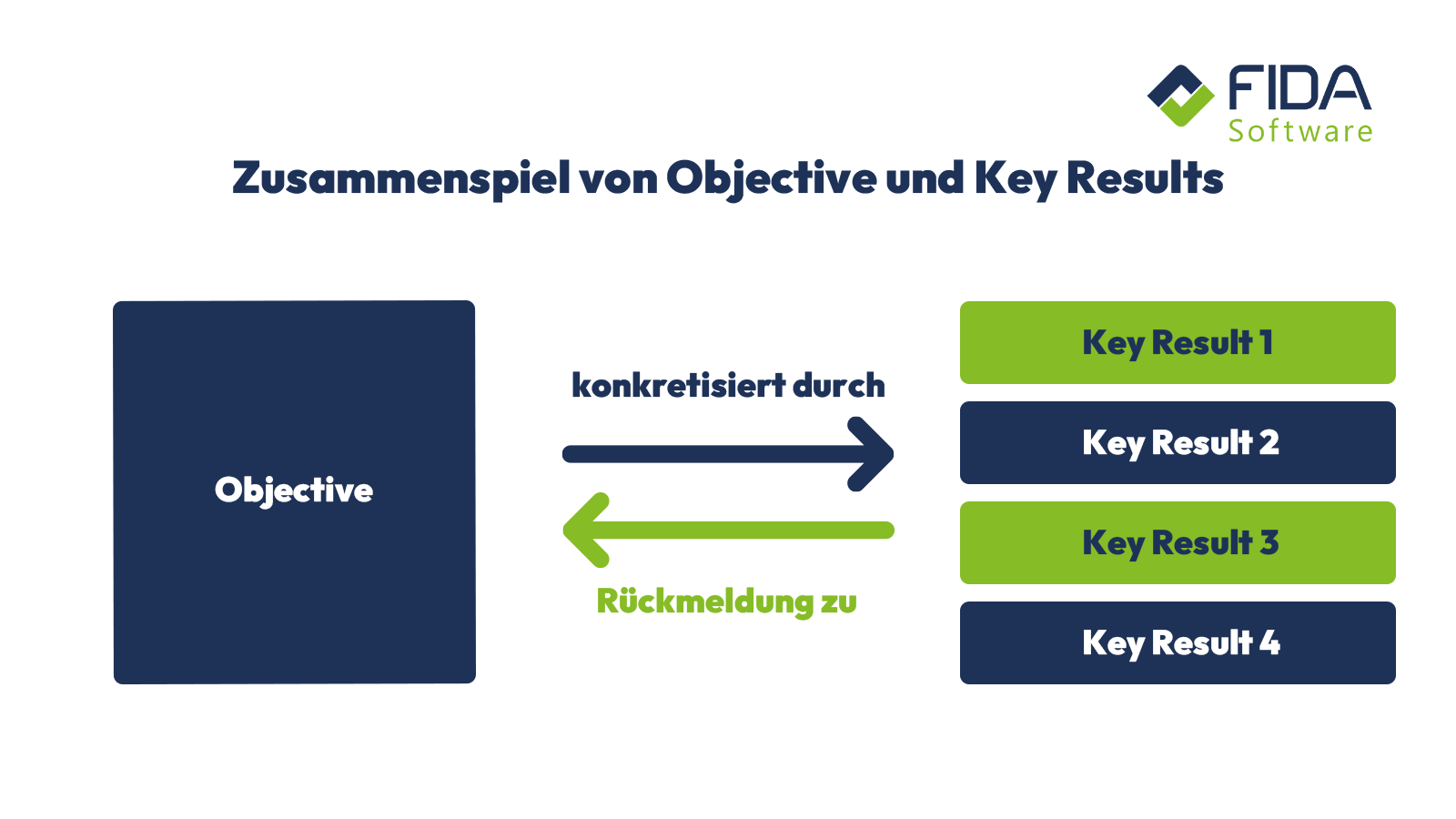
Pillar 2: OKR architecture - linking strategy and operational implementation
The second pillar is the OKR architecture. It ensures that strategic corporate goals are meaningfully linked with the goals of the teams. The corporate strategy forms the basis for the development of the OKR architecture by serving as the starting point for setting goals and defining objectives. OKRs act as a bridge between the strategic vision and the operational implementation by linking the long-term goals with the daily tasks and thus creating clarity and transparency in the entire management system.
A good architecture is characterized by top-level OKRs for the company or business units and team OKRs for individual teams or departments. A clear interplay of top-down specifications and bottom-up contributions ensures a coherent interlocking. The structure should also be kept as flat as possible to avoid complexity.
There are typically two levels: At the upper level, management defines 2 to 5 top-level OCRs with a time horizon of 12 to 36 months. At the operational level, the teams independently formulate 1 to 3 OKRs for periods of 2 to 4 months.
Many companies use so-called MOALs (Mid-Term Goals) at the top level. However, it is advisable to consistently use OKRs at this level too, as they force a clear definition of objectives, promote accountability in management and ensure a consistent architecture across all levels.
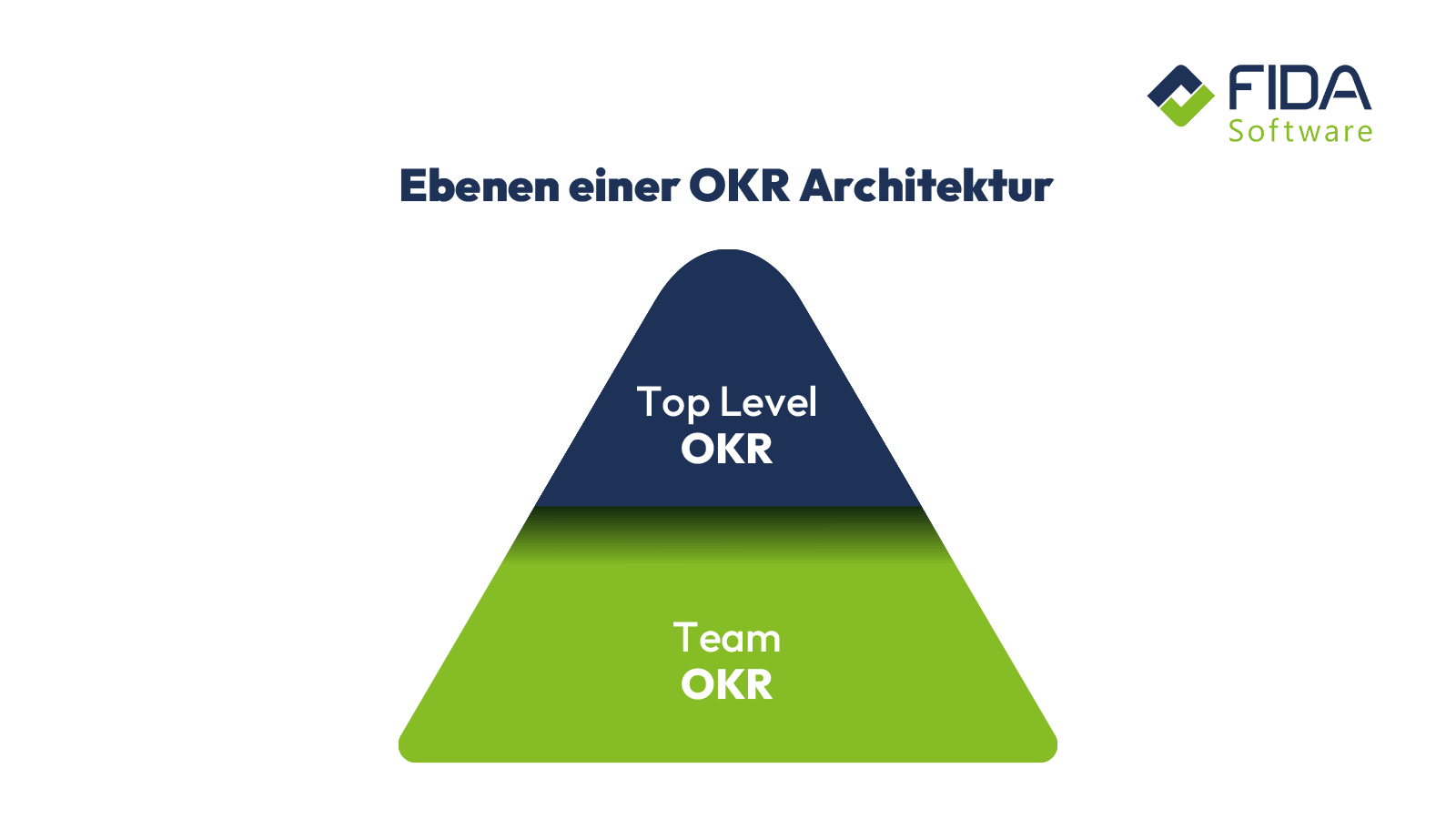
Pillar 3: OKR process - OKR as an agile cycle
The third pillar is the OKR process, a clearly structured, iterative process for the implementation and further development of the set goals. Clearly defined processes are crucial to ensure the connection between corporate goals and their implementation through concrete workflows. The OKR framework serves as a flexible framework and management system that enables the continuous development, measurement and evaluation of target achievement based on key performance indicators and key results.
Step 1
Planning takes place at the beginning of a cycle, in which teams formulate their OKRs for the coming period, coordinate them within the team and synchronize them with the corporate goals. A central task in the planning process is to identify and clearly formulate the most important objectives, as setting OKRs is a challenging task that requires careful consideration and selection.
Step 2
During the cycle, there are regular check-ins where progress is reviewed and the team assesses its confidence level - i.e. how confident it is of achieving the objectives.
Step 3
At the end of the cycle, there is a review or demo in which the results, successes and learnings are presented.
Step 4
Finally, a retrospective takes place in which the process itself is reflected upon: What worked well, what didn't, and how can the work with OKRs be improved? OKR frameworks offer a flexible guideline for continuously developing the methodology as part of the retrospective and adapting it to the individual requirements of the team.
Top-level OKRs usually have longer time horizons, around 12 months, while team OKRs often cover shorter periods of around 3 months. The different levels are regularly linked with each other, for example through joint reviews.
The process is crucial, as regular reflection ("Inspect & Adapt") is the central lever for continuous improvement. Poor formulations or a weak architecture quickly become visible in the process. Only with consistent implementation will OKR become a real instrument for success.
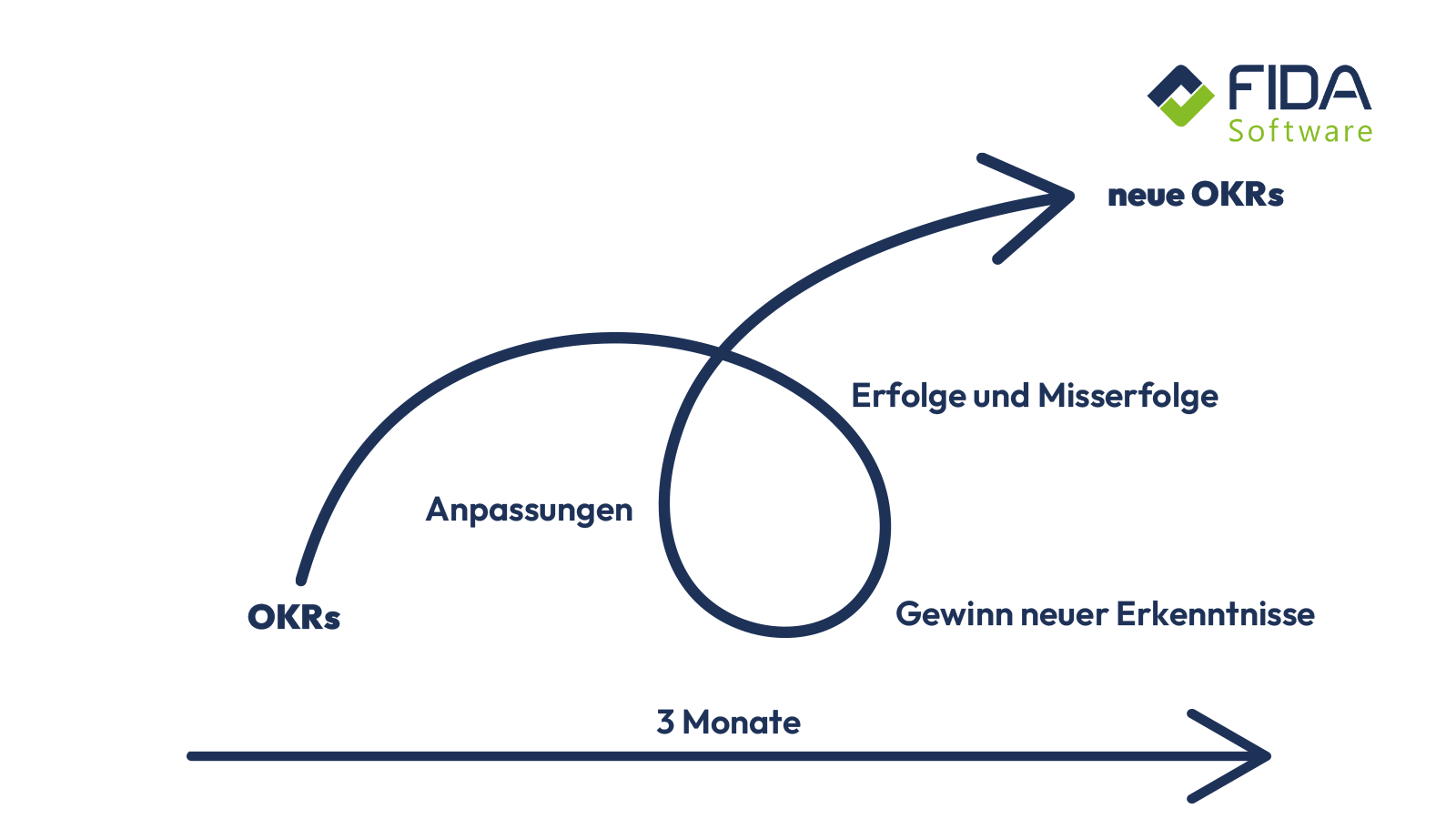
OKR Tracking - Confidence Level
Confidence levels are an important part of the OKR process. These express your confidence in achieving an OKR in a number between 0 and 1.
Confidence levels allow you to evaluate and communicate the progress of your OKRs quickly and easily at any time. Tracking therefore facilitates regular communication within the team and management. You can find instructions on how to formulate good confidence levels in another article.
Example 1: Intel - Operation Crush (1979-1980)
This historical OKR comes directly from early Intel history. At the end of the 1970s, Intel was in direct competition with Motorola's 68000 chip. Andy Grove and his team then formulated a tough objective:
Intel - Objective:
Position the Intel 8086 as the most powerful 16-bit microprocessor.
Intel - Key Results:
Acquire 2,000 "design wins" - that is, manufacturers adopting the 8086
Publish five benchmark studies on performance superiority
Develop demo versions and training materials
Conduct at least three customer visits to validate the 8086
Thanks to this clear, ambitious OKR, Intel mobilized its entire organization within a few quarters. By 1986, the 8086 had already captured around 85% of the 16-bit market - a clear victory that is often cited as a prime example of the impact of OKR.
Example 2: Google - Introduction of OKRs (1999+today)
John Doerr brought the OKR framework to Google in 1999 after learning about it at Intel. In his presentation, the founders defined an initial OKR for the first test phase:
Google - Objective:
Establish a planning system for Google
Google - Key Results:
Complete presentation on time
Create sample OKRs for one quarter
Get management approval for a three-month OKR test
Thanks to this initiative, OKR quickly became the central management method at Google. Larry Page later said that OKR enabled "10x growth" and was instrumental in realizing Google's mission to "organize the world's information".
Example 3: OKRs in use at FIDA
FIDA also lives the principles of the OKR method internally: for example, we use OKRs specifically in our own strategy projects to clearly define our internal goals, make progress measurable and optimize cross-team collaboration. This not only enables us to drive our projects forward more efficiently, but also to continuously deepen our expertise in the practical application of OKRs.
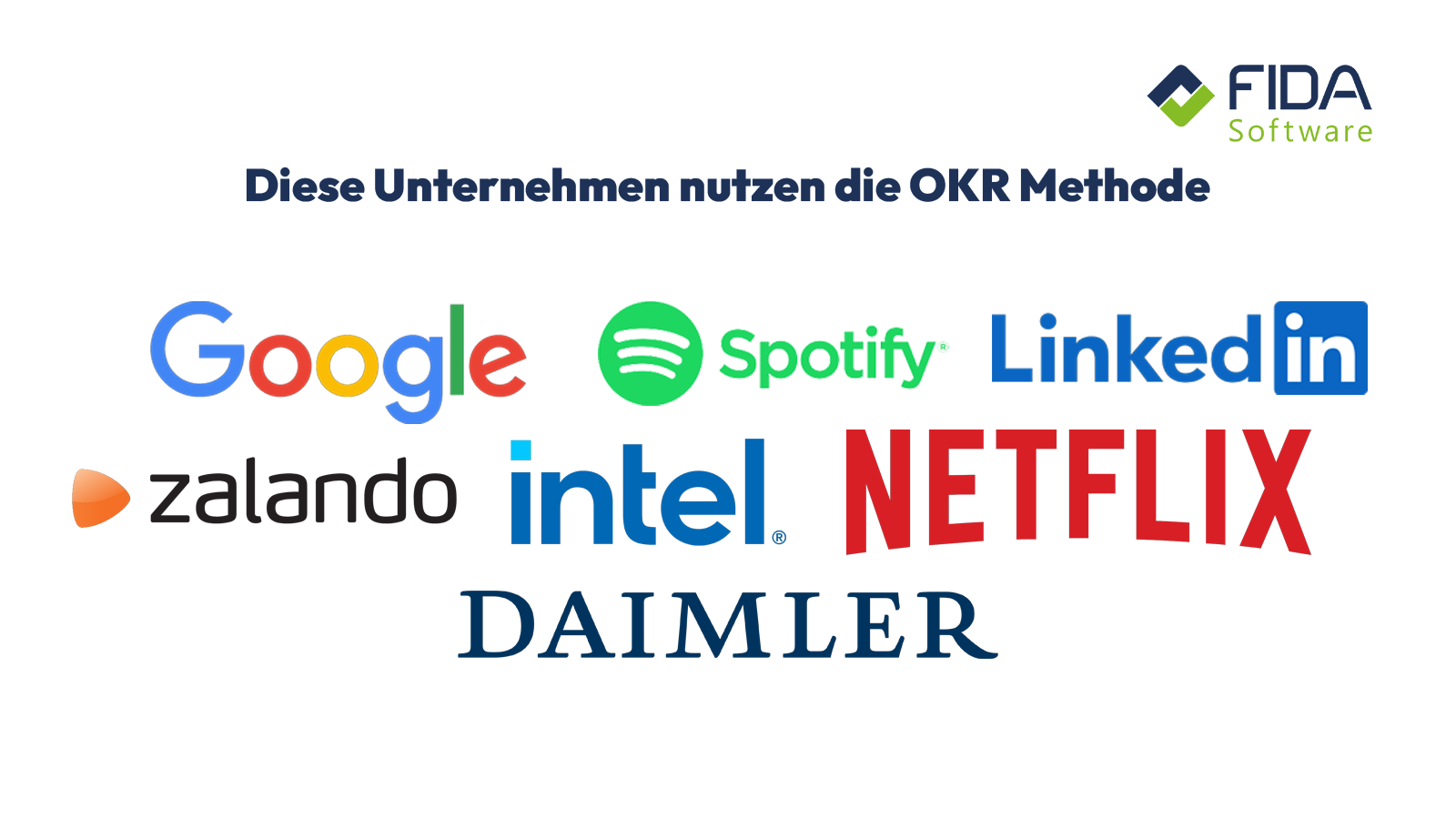
OKR masters and coaches
In order to moderate the OKR process effectively, you should establish one or more OKR coaches in your organization. We can help you here and provide you with experienced project managers!
Top OKR tools for successful goal setting
Selecting the right OKR tool is crucial for efficient and sustainable implementation of the OKR method in your company. A comprehensive guide to selecting OKR tools can help you make the right decision and structure the selection process. Also make sure that the provider's website is user-friendly so that you can select and use the tool optimally. Different providers offer different strengths depending on company size, needs and integration requirements. Here is an overview of some of the best OKR tools on the market:

Mooncamp
Mooncamp impresses with its flexible and comprehensive platform, which is particularly suitable for medium-sized and large companies. The tool can be easily integrated into many existing applications and offers extensive functions for OKR management. Mooncamp supports teams in making goals transparent and continuously tracking progress.

Profit.co
Profit.co combines OKR management with task tracking and an integrated reward system. This combination makes it particularly attractive for teams that want to closely link their OKRs with day-to-day business. The platform promotes both motivation and targeted implementation.

Perdoo
Perdoo impresses with its user-friendliness and is therefore a good choice for start-ups and smaller companies that are just starting out with OKRs. Its ease of use facilitates implementation and ensures that teams can work quickly and effectively with OKRs.

Workpath
Workpath is primarily aimed at large organizations that are looking for a powerful tool as well as consulting and training. With a focus on strategic implementation, Workpath helps companies not only to manage OKRs, but also to integrate them into the corporate culture in the long term.
These tools help companies to implement OKRs in a transparent, measurable and targeted manner - important prerequisites for sustainable success with the OKR method.
Common mistakes when introducing the OKR method
When introducing OKRs, companies repeatedly make similar mistakes that jeopardize the success of the method. Uncertainty or lack of clarity often ensures that the implementation does not succeed optimally.
Incorrect cascading of goals
A classic mistake is to transfer goals strictly from top to bottom - from management to the teams, and then on to the individual employees. This waterfall model contradicts the agile principle of OKRs.
Instead, goals should be both set from the top and shaped by the teams themselves. This dual approach promotes the self-organization of the teams, ensures better coordination upwards and among each other and makes the connection between team goals and company goals transparent.
Do not use OKRs as a control instrument
OKRs are not a tool for performance evaluation or bonus payments. If employees measure their targets against them, they may deliberately set low targets in order to achieve them more easily - a phenomenon known as "sandbagging". This significantly reduces the impact of OKRs and inhibits ambitious work.
Do not define everyday tasks as OKRs
OKRs should be ambitious goals that promote growth and further development. If daily routine activities or status quo goals are defined as OKRs instead, the necessary challenge and motivation are missing.
Do not see key results as to-do lists
Key results are often wrongly formulated as mere to-do lists. However, key results should represent measurable results, not simply activities to be carried out. The focus is on actual results (outcomes), not on mere output.
Frequently asked questions about the OKR method and OKR introduction
We frequently receive questions from customers and interested parties about the application of the OKR method. A clear definition of OKR forms the basis for understanding this method and its objectives. We have summarized the most important answers here - perhaps they will help you too.
Are key results with milestones permissible instead of measurable key figures?
In principle, key results should always be based on relevant metrics that measure a concrete result (outcome) - not just the mere output. Milestones are usually more part of the output and are therefore more suitable than initiatives or tasks that support the progress of a key result.
Particularly in early phases, when the foundations have to be laid first, it can be difficult to formulate directly measurable key results. In such cases, milestones are sometimes temporarily defined as key results, but this should only be a temporary solution.
Should personal OKRs be introduced for individual employees?
We recommend concentrating OKRs at company and team level and refraining from individual OKRs. There are two reasons for this: Firstly, the number of OKRs increases greatly with individual targets, which makes administration considerably more complex.
Secondly, there is a risk that individual OKRs will be linked to performance appraisals or remuneration. This can weaken intrinsic motivation and impair the actual benefits of the OKR method.
What is the difference between OKRs and KPIs?
KPIs (Key Performance Indicators) are indicators that an organization uses to measure its performance, such as sales, profit or customer satisfaction. OKRs, on the other hand, are short-term, ambitious targets designed to ensure that these KPIs are achieved or improved.
Most key results contain a KPI or a related, influenceable key figure (lead measure). Example: "Increase the profit margin to 20 %" - here the profit margin is the KPI and the entire target is the key result.
How do OKRs differ from MBO (Management by Objectives)?
OKRs have their origins in the MBO concept, but differ in several important ways:
While MBO mainly defines what is to be achieved, OKRs additionally define the how through measurable results.
MBO targets are usually reviewed annually, whereas OKRs are reviewed in shorter cycles of three to four months.
MBO targets are often private and siloed, whereas OKRs are transparent and shared publicly within the company.
MBOs are often linked to remuneration, which should be avoided with OKRs so as not to impair motivation.
MBO targets tend to be set conservatively, whereas OKRs deliberately pursue ambitious targets that promote growth.
Conclusion: Measure what matters! OKR as the key to more agility and focus in the company
The OKR method offers companies a powerful structure for formulating ambitious goals transparently and making progress measurable. The combination of clearly defined objectives with quantifiable key results creates a dynamic framework that effectively supports both strategic alignment and operational implementation.
OKRs promote the self-organization of teams, create a common language for success and enable regular reflection and adjustments - decisive factors for greater agility and sustainable corporate success.
However, the introduction and consistent application of OKRs is not a sure-fire success. It requires a well thought-out OKR architecture, the right target hierarchy and, above all, discipline in the OKR process. Many organizations face challenges such as formulating goals correctly, avoiding typical mistakes or establishing a continuous improvement cycle.
If you would like to support your organization in the introduction or optimization of OKRs, we are happy to be your partner. With our experience in agile methods and targeted consulting, we can help you to implement OKRs effectively, strengthen team communication and make the transition to greater agility sustainable.
Contact us to find out more about how we can help you organize agile projects and successfully introduce OKRs. Together, we will get to the heart of your goals - transparently, measurably and effectively.
FAQ - How do I use OKRs correctly?
OKR stands for Objectives and Key Results. Objectives are qualitative, directional goals; key results are measurable indicators that are used to determine whether and how well a goal has been achieved.
OKRs create focus on the most important goals, ensure transparency at all levels, enable better alignment between corporate strategy and operational activities and promote agility, as they can be regularly reviewed and adapted.
Good objectives are inspiring, clearly formulated and ambitious. Key results should be quantitative, specific, achievable and time-bound - they show the way to the goals and can be measured objectively.
OKR cycles of three to four months are ideal. This period provides enough time to see an impact and at the same time the flexibility to adjust targets if necessary.
The following are required
clear responsibilities, e.g. OKR owner or champions
Transparency of all goals in the company
Regular review meetings (check-ins, reviews, retrospectives)
Managers who support and exemplify the method
a culture in which learning, feedback and adaptation are welcome
Frequent errors:
Too many objectives at the same time
Key results that are not measurable
Unrealistic or unambitious goals
Lack of transparency or lack of employee involvement
Avoidance through a small, focused set of OKRs, clear metrics, realistic assessments and constant communication & feedback.
Success can be measured by evaluating key results - e.g. with percentages or quantitative values. It is also essential that progress is made visible and regularly reflected upon, e.g. in reviews and retrospectives. A target achievement rate of around 70% is often a sign that the targets were ambitious, but feasible.
By making OKRs part of the corporate culture, regularly reassessing them and promoting continuous learning. Feedback loops, adjustments, training and the involvement of all employees are important. Integration with other processes (e.g. strategy meetings, operational planning) also helps to make OKRs effective in the long term.
